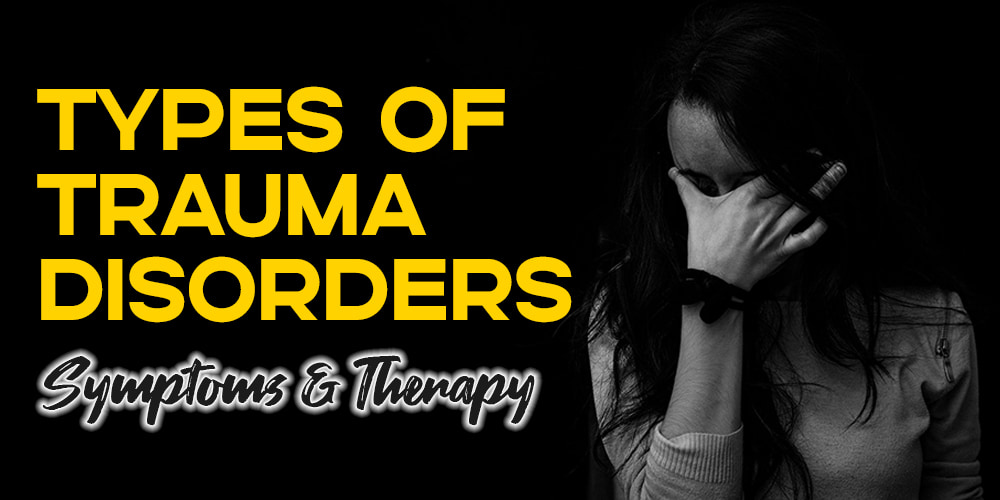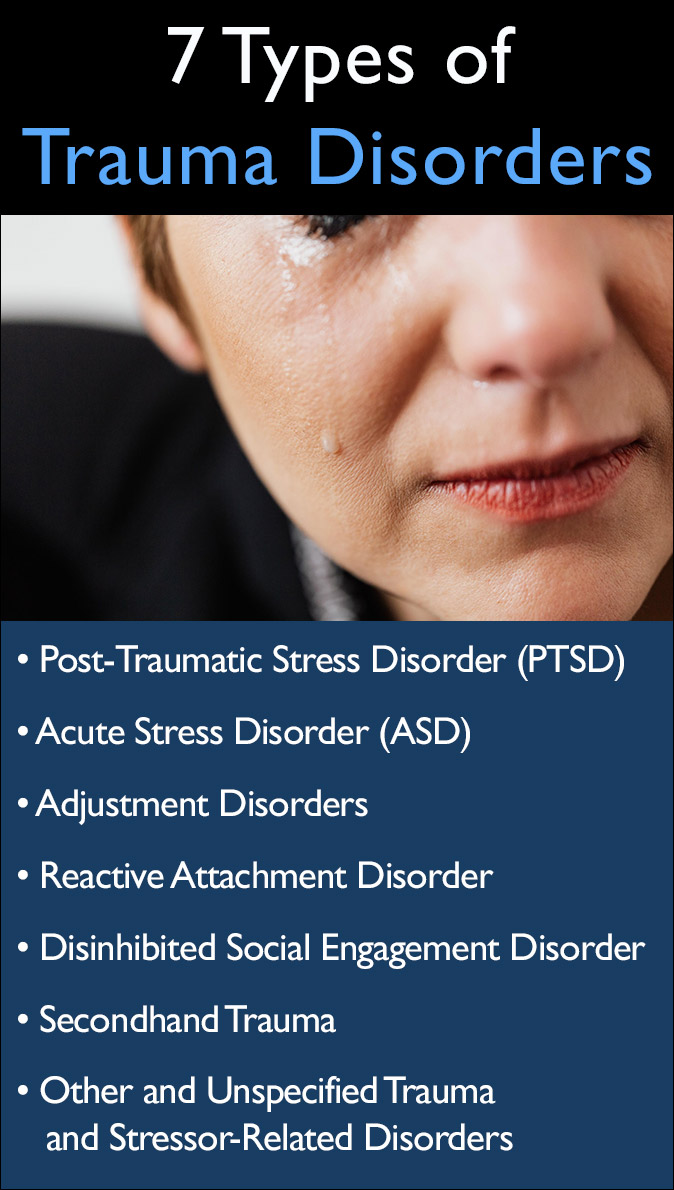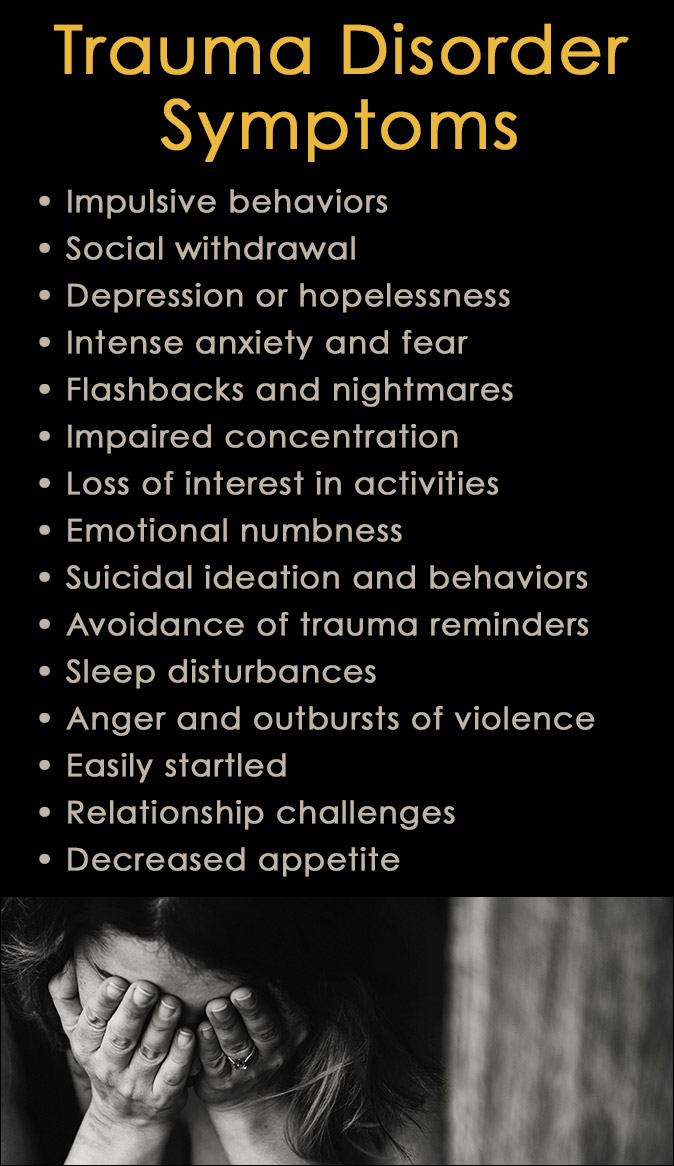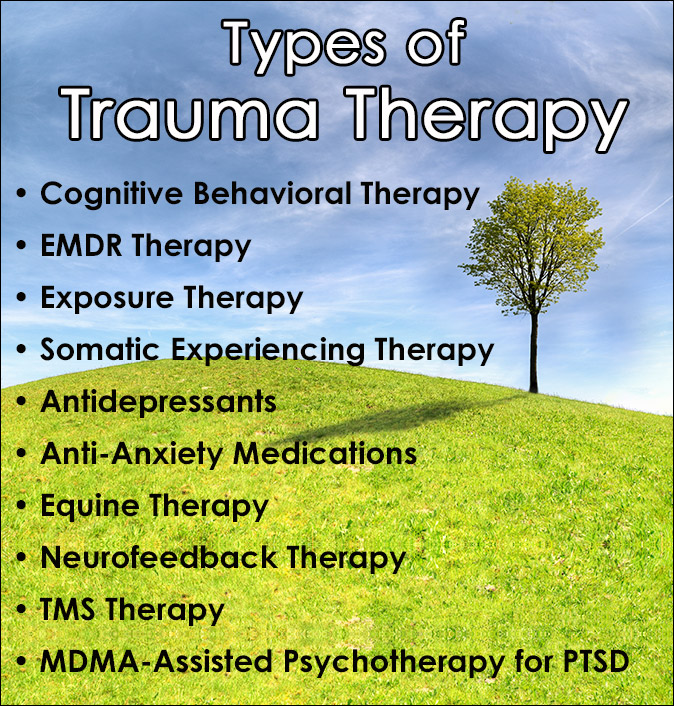
There are different types of trauma disorders that usually develop from directly experiencing or witnessing distressing events.
With approximately 8 million Americans encountering traumatic events annually, the prevalence of various types of trauma disorders is significant, as reported by The National Center for PTSD.
The good news is that effective treatment options, including successful types of trauma therapy approaches and medications are available to address these mental health disorders.
What are Trauma Disorders?
Trauma Disorders are classified as “Trauma and Stressor-related Disorders” in the DSM-5 and are usually influenced by traumatic events.
These types of disorders result in feelings of stress, fear, anxiety, and depression, and can manifest as nightmares and flashbacks.
Trauma and stressor related disorders can also impact behavior and often lead to anger, outbursts, social isolation, and other negative consequences, such as work and relationship difficulties.
Types of Trauma Disorders
Trauma itself is a subjective phenomenon, meaning that individuals can have varying responses to similar events.
Examples of traumatic events include:
- Abuse
- Neglect
- Witnessing violence
- Bereavement
- Car accidents
- Sexual assault
There are distinct types of trauma and stressor-related disorders, each with its own set of diagnostic criteria.

7 Types of Trauma Disorders
1. Post-Traumatic Stress Disorder (PTSD)
Post-Traumatic Stress Disorder (PTSD) is a condition that emerges following a traumatic event, such as experiencing assault or witnessing a murder.
There are 5 main types of PTSD that can cause a number of symptoms like nightmares, intense fear, flashbacks, and avoidance.
PTSD can profoundly impact a person’s daily functioning and quality of life. Fortunately, there are effective trauma therapy approaches to help with recovery.
2. Acute Stress Disorder (ASD)
Acute Stress Disorder (ASD) arises from traumatic experiences. However, the response to trauma in ASD is abrupt and shorter-lived compared to PTSD.
While acute stress disorder symptoms may endure for a period ranging from a few days to a month, the manifestations of PTSD persist for more than a month.
3. Adjustment Disorders (AD)
Adjustment Disorders (AD) are an exaggerated response to stressful or challenging life events, such as losing a loved one or ending a relationship.
These reactions exceed what would typically be expected and indicate a limited ability to cope effectively.
Adjustment Disorders include six distinct types, with each one characterized by dominant symptoms such as:
- Anxiety
- Depression
- Comorbid anxiety and depression
- Maladaptive behaviors
- Maladaptive behaviors accompanied by depression and anxiety
- Unspecified presentation
4. Reactive Attachment Disorder (RAD)
Reactive Attachment Disorder (RAD) is a relatively uncommon condition and usually observed in children who fail to form healthy attachments with their primary caregiver, often due to unmet needs.
A lack of nurturing and support can constitute a form of trauma. Infants or children with reactive attachment disorder may exhibit withdrawal, sadness, fear, lethargy, and a disinterest in social interactions.
If not treated, childhood trauma can impact people later in their adult life.
5. Disinhibited Social Engagement Disorder (DSED)
Disinhibited Social Engagement Disorder (DSED) is another type of trauma disorder that impacts children who have experienced neglect or other forms of trauma.
The symptoms are usually milder than those of reactive attachment disorder, yet they still present challenges in establishing relationships and engaging in socially appropriate behaviors.
6. Other and Unspecified Trauma and Stressor-Related Disorders
Other and Unspecified Trauma and Stressor-Related Disorders is sometimes referred to as Unclassified and Unspecified Trauma Disorders.
The classification of unspecified trauma and stressor-related disorders is sometimes used by psychiatrists and medical professionals when a person exhibits some, but not all symptoms of a specific condition.
It is also used when there is insufficient information to make a more precise diagnosis.
7. Secondhand Trauma
Secondhand Trauma also goes by the names Secondary Trauma, Vicarious Trauma, or Secondary Traumatic Stress Disorder.
This type of trauma disorder occurs when a person witnesses somebody else experiencing trauma and he or she is indirectly affected by it.
An example of this would be a child witnessing ongoing physical abuse inflicted upon a parent. Signs of secondary trauma are feelings of guilt, fear, anger, cynicism, and a sense of inadequacy.

Symptoms of Trauma Disorders
Each of the unique types of trauma disorders include a range of symptoms and diagnostic criteria.
Despite their distinct classifications, these related conditions often overlap each other and share common signs and symptoms.
Symptoms of Most Types of Trauma Disorders Include:
- Impulsive behaviors
- Social withdrawal
- Depression
- Feelings of hopelessness or helplessness
- Intense anxiety and fear
- Flashbacks, intrusive thoughts, and nightmares
- Impaired concentration and cognitive difficulties
- Loss of interest in activities previously enjoyed
- Emotional numbness
- Anhedonia or the inability to experience joy
- Suicidal ideation and behaviors
- Avoidance of trauma reminders
- Sleep disturbances such as sleeping too much or not at all
- Anger and outbursts of violence
- Heightened response to being startled and persistent vigilance
- Challenges in forming relationships or engaging with other people
- Decreased appetite
Types of Trauma Therapy
The most successful types of therapy for trauma disorders focus on addressing the symptoms as well as the underlying causes of trauma and stress.
Various therapeutic approaches, including psychotherapy and medication, help individuals recover and regain control over their life again.
With the support of trained professionals, individuals will find effective strategies for managing trauma disorders to improve mental well-being and quality of life.

Common Types of Therapy Include:
Cognitive Behavioral Therapy (CBT)
Cognitive Behavioral Therapy (CBT) focuses on the relationship between thoughts, emotions, and behaviors. It addresses present challenges and symptoms while actively modifying behavior, thoughts, and emotional patterns.
Eye Movement Desensitization and Reprocessing (EMDR)
Eye Movement Desensitization and Reprocessing (EMDR) offers an alternative approach where an individual may not necessarily need to disclose his or her traumatic experience to a therapist verbally.
Instead, the focus is on directing attention toward the trauma while engaging in specific bilateral stimulation techniques, such as hand movements, light flashes, or auditory cues.
The objective of EMDR Therapy is to enable a person to hold a positive thought or image in the mind while recalling the traumatic memory.
Exposure Therapy PE (Prolonged Exposure)
Exposure Therapy PE (Prolonged Exposure) typically involves eight to 15 sessions, each lasting approximately 90 minutes.
During the initial stages of treatment, the therapist will guide the patient in learning breathing techniques to reduce anxiety when confronting the memories of a traumatic event.
As therapy progresses, the patient will work on creating a list of avoided situations or triggers and gradually face them.
In a specific session, the patient will narrate the traumatic experience to his or her therapist, then listen to a recording of the therapy session to recount the event at home.
Somatic Experiencing Therapy
Somatic Experiencing Therapy is a treatment method that can be effective for resolving past traumatic experiences and has shown positive results for people with PTSD and other types of trauma disorders.
It works by helping people rebuild an emotional balance to feel whole again.
Antidepressants and Anti-Anxiety Medications
Antidepressants and anti-anxiety medications for depression and anxiety symptoms can be beneficial in treating PTSD and other types of trauma disorders by affecting the balance of neurotransmitters like serotonin, norepinephrine, and dopamine.
It’s important to note that some antidepressants also effectively address comorbid major depressive disorder (MDD), which frequently coexists with PTSD.
Sertraline (Zoloft) and Paroxetine (Paxil) are two forms of SSRIs that are FDA approved for treating PTSD.
However, exceptions may arise based on individual factors such as side effects, response, comorbidities, and patient preferences.
For instance, patients with comorbid bipolar disorder may require mood stabilizers before prescribing SSRIs to manage mood instability.
Tailoring medications and dosages to individual needs is crucial, and research suggests that optimal outcomes depend on adequate dosages and duration of treatment.
While medications and trauma therapy alone may help for many people, combining them often provides the best outcome for many individuals.
Other Types of Therapy
The trauma therapy methods described above are some of the most common approaches to healing trauma and stressor related disorders.
Although many of them work well for a large segment of people, there are other alternative approaches that have shown promise, either for treating trauma disorders, or the related symptoms associated with trauma.
Additional Therapies for Some Types of Trauma Disorders Include:
- Equine Therapy
- Neurofeedback or Brainpaint Therapy
- TMS Therapy
Each person has a unique set of causes and symptoms related to his or her types of trauma disorders.
What works for person may not work for another, so it is important to offer a wide range of treatment options for recovery and healing.
FAQs
What are the most commonly diagnosed trauma disorders?
The most commonly diagnosed adult trauma disorders in the DSM-5 include:
Post-Traumatic Stress Disorder (PTSD) is the most commonly diagnosed trauma disorder, and it develops after experiencing a traumatic event. The symptoms include anxiety, nightmares, and flashbacks that continue for more than a month.
Acute Stress Disorder is similar to PTSD and is also quite common although the symptoms last less than a month.
Adjustment Disorders occur after a stressful event and the symptoms of anxiety or depression are more severe than a normal stress response.
Secondhand Trauma has symptoms that resemble those of PTSD, and it affects individuals who are exposed to the trauma of others.
How common is PTSD compared to other trauma-related disorders?
According to the National Center for PTSD, approximately 6 percent of people in the United States will experience PTSD at some point in their life.
The latest data shows that 13 million people in America had PTSD in 2020.
Acute Stress Disorder and other trauma disorders all occur at lower rates than PTSD.
Is there a difference between PTSD and other trauma disorders?
Yes, there is a difference between PTSD and other trauma disorders in the way it develops, the symptoms, and diagnostic criteria.
Trauma is an emotional and psychological response to a traumatic event that causes a variety of disorders.
PTSD is one type of trauma disorder with specific symptoms that significantly impact daily life and persist longer than a month.
What medications are prescribed for trauma disorders?
Antidepressant medications like SSRIs and SNRIs are generally prescribed for PTSD and trauma disorders, and the most common ones include:
- Sertraline (Zoloft)
- Paroxetine (Paxil)
- Venlafaxine (Effexor XR)
- Fluoxetine (Prozac)
- Prazosin
- Risperidone
- Lamotrigine
Of these, Sertraline and Paroxetine are the only ones FDA-approved for PTSD. All the others are used off-label or to treat specific symptoms related to the trauma disorder.
When was Trauma and Stressor-related Disorders added to the DSM?
The category, ‘Trauma and Stressor-Related Disorders,’ was added to the fifth edition of the Diagnostic and Statistical Manual of Mental Disorders in 2013 with the publication of the DSM-5.
PTSD and trauma-related disorders were previously classified as Anxiety Disorders in earlier DSM editions.
Related Posts
- 5 Types of PTSD and Treatment Therapy
Anyone can experience post-traumatic stress disorder symptoms and recognizing the different types of PTSD will…
- Types of Anxiety Disorders Symptoms, Causes, Treatments
Everyone experiences some form of anxiety once in a while, but when it becomes a…
- Somatic Experiencing Therapy for Trauma Healing
Trauma or PTSD can be debilitating for many people, but fortunately a form of Somatic…
